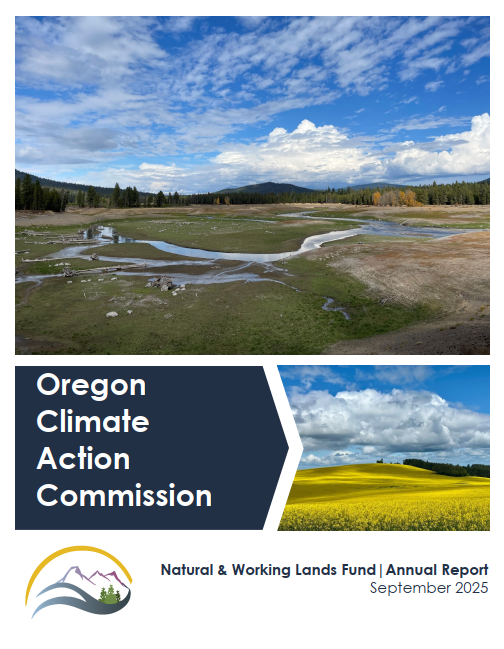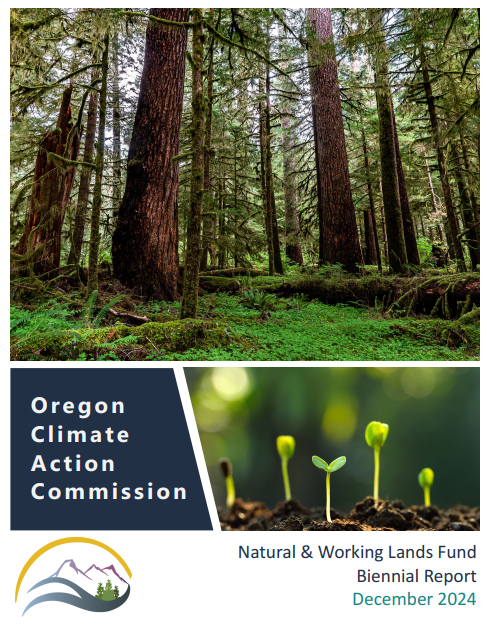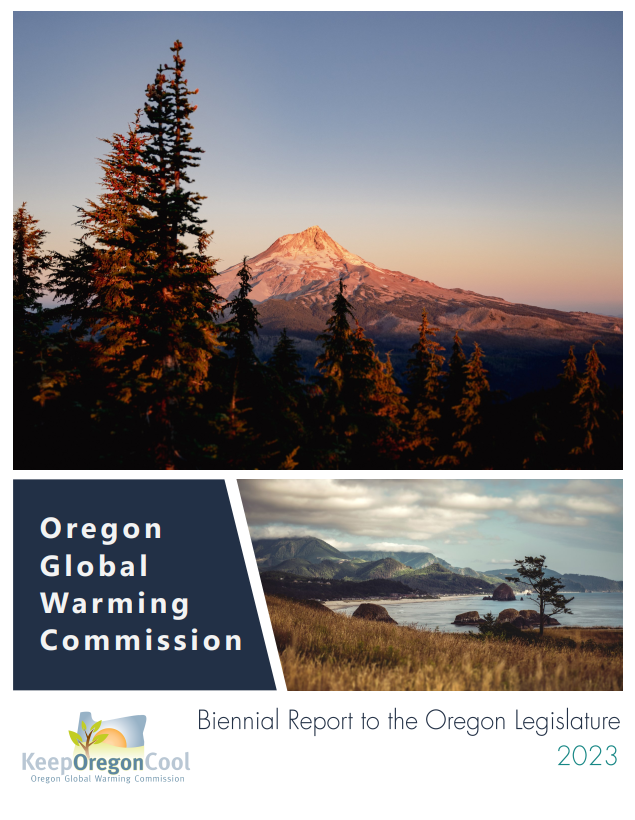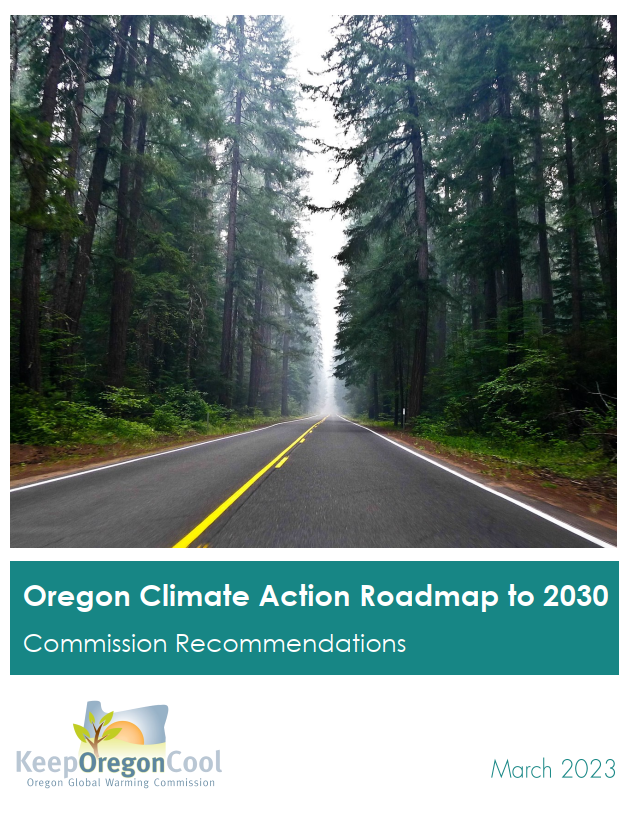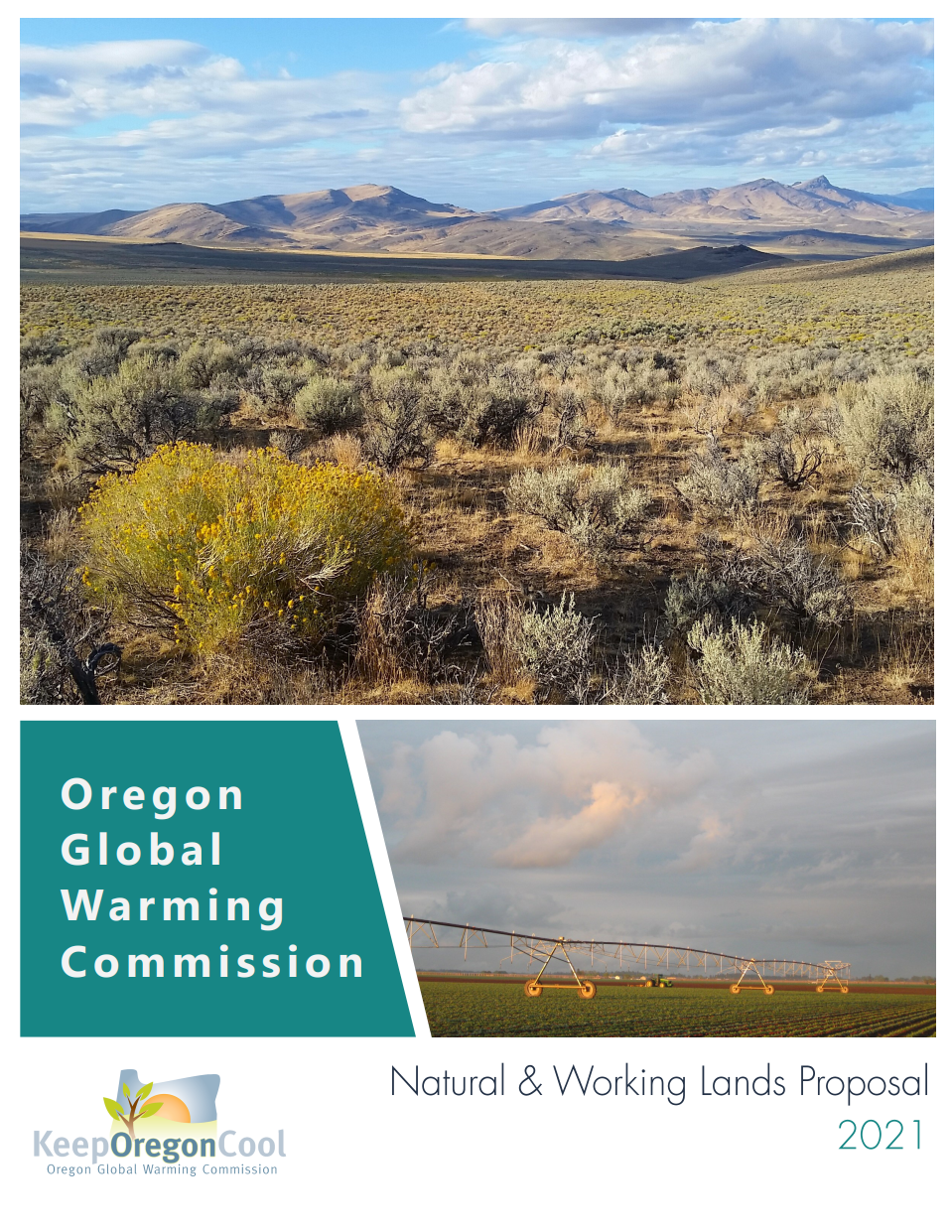Oregon Climate Action Commission Reports
The commission delivers a biennial report to the Legislature by December 1 of even-numbered years.* The commission also does special reports on key topics as needed and as resources allow.
Generally, the commission uses the reports as a platform to educate and inform legislators and the public about current critical climate facts, policies, and strategies, as well as periodically make recommendations to the Legislature on updating Oregon’s greenhouse gas emission reduction goals based on best available science.
A brief summary and link to each report is included below. Please note reports and studies completed prior to 2024 were submitted under the name Oregon Global Warming Commission.
Questions or comments about our reports? Contact us!
*Reports were previously submitted by the Oregon Global Warming Commission in the spring of odd-numbered years.
HB 3409 (2023) directed the Oregon Climate Action Commission, the Oregon Department of Energy, and seven land managing agencies to track outcome-based progress for natural climate solutions project implementation on natural and working lands and establish an accounting system fundamental to tracking greenhouse gases in Oregon’s landscape. The Land-based Net Carbon Inventory (Inventory) accounts for greenhouse gas emissions and carbon removals across Oregon’s lands over time and is the subject of this report. Oregon’s first Inventory establishes a historical baseline for carbon in specific pools and establishes rates of emissions and sequestration in Oregon’s ecosystems. It provides the state, decision-makers, and the public a better understanding of the effects of the past 35 years of changes to Oregon’s land on its GHG emissions and removals.
The Natural Climate Solutions Workforce Development and Training Programs Needs Study assesses Oregon’s Natural Climate Solutions workforce and related workforce development and training programs to identify gaps and opportunities for growing this workforce’s ability to meet Oregon’s climate goals. The Oregon Legislature passed House Bill 3409 in 2023, directing ODOE to complete this assessment. It also established a state policy to implement natural climate solutions to help mitigate the future impacts of climate change and established Oregon’s Natural and Working Lands Fund to support investments in natural climate solutions implementation across Oregon – a need highlighted in Executive Order 20-04 signed in 2020. In 2025, Governor Tina Kotek issued Executive Order 25-26 on the Resilience of Natural & Working Lands; successful implementation of this executive order will also rely on the NCS workforce to meet land-based resilience goals.
2025 Natural & Working Lands Fund Annual Report
Through the adoption of HB 3409 in 2023, the Oregon Legislature established the state’s Natural and Working Lands Fund to support investments in natural climate solutions on Oregon’s natural and working lands. As approved by the Oregon Climate Action Commission in early 2024, the Fund’s initial $10 million appropriation was allocated between the Oregon Department of Agriculture, the Oregon Department of Fish & Wildlife, the Oregon Department of Forestry, and the Oregon Watershed Enhancement Board to support a variety of programs and projects to advance nature-based climate solutions. The Oregon Climate Action Commission’s 2025 Natural & Working Lands Fund Annual Report summarizes the agencies’ initial investments and progress in advancing actions to enhance net carbon sequestration and storage on natural and working lands. The report’s appendix provides updated descriptions of the Natural & Working Lands Fund investment areas.
2024 Natural & Working Lands Fund Biennial Report
Through the adoption of HB 3409 in 2023, the Oregon Legislature established the state’s Natural and Working Lands Fund to support investments in natural climate solutions on Oregon’s natural and working lands. As approved by the Oregon Climate Action Commission in early 2024, the Fund’s initial $10 million appropriation was allocated between the Oregon Department of Agriculture, the Oregon Department of Fish & Wildlife, the Oregon Department of Forestry, and the Oregon Watershed Enhancement Board to support a variety of programs and projects to advance nature-based climate solutions. This biennial report provides an update to the Oregon Climate Action Commission’s 2024 Natural & Working Lands Fund Annual Report. It summarizes the agencies’ initial investments and progress in administering and implementing projects and funds to enhance net carbon sequestration and storage on natural and working lands.
2024 Biennial Report to the Legislature
The OCAC’s 2024 Biennial Report provides key foundational information on the state’s climate change impacts, emission trends, and progress toward achieving Oregon’s greenhouse gas (GHG) emissions reduction goals. In this report, the OCAC strongly recommends that the Legislature direct new actions and fully fund existing priority climate programs. The Commission highlights additional actions the Legislature and agencies should take to help Oregon stay on track toward its GHG mitigation goals as outlined in the OCAC’s Oregon Climate Action Roadmap to 2030 (Roadmap).
Although the 2024 Biennial Report highlights strong progress in implementing the state’s climate actions, Oregon’s sector-based emissions continue to trend flat, and its consumption-based emissions have dramatically increased. In addition, several key climate programs designed to significantly reduce emissions have not had time to effect change, have had setbacks, or need complementary action and funding to meet their potential. The report uplifts several key Roadmap recommendations that still require action by the Legislature, and recommends new actions based on their GHG emissions reduction potential; importance to a rapid and equitable transition to a clean energy and sustainable future; as well as the opportunities the Commission anticipates for advancing climate action in 2025 and 2026.
2024 Natural & Working Lands Fund Annual Report
Through the adoption of HB 3409 in 2023, the Oregon Legislature established the state’s Natural and Working Lands Fund to support investments in natural climate solutions on Oregon’s natural and working lands. As approved by the Oregon Climate Action Commission in early 2024, the Fund’s initial $10 million appropriation was allocated between the Oregon Department of Agriculture, the Oregon Department of Fish & Wildlife, the Oregon Department of Forestry, and the Oregon Watershed Enhancement Board to support a variety of programs and projects to advance nature-based climate solutions. The Oregon Climate Action Commission’s 2024 Natural & Working Lands Fund Annual Report summarizes the agencies’ initial investments and early progress in advancing actions to enhance net carbon sequestration and storage on natural and working lands. The report’s appendix provides updated descriptions of the Natural & Working Lands Fund investment areas.
2023 Biennial Report to the Legislature
Unlike previous biennial reports, the 2023 Report to the Legislature does not include recommendations. Instead, the Commission developed its Oregon Climate Action Roadmap to 2030 in parallel, which includes extensive recommendations to inform state climate action moving forward, some of which are highlighted in this 2023 Report to the Legislature. However, the report continues to provide key foundational information on state climate impacts, emission trends, and progress towards achieving Oregon’s GHG emission reduction goals.
According to preliminary emissions data, despite an overall reduction in emissions in 2020 due to the COVID-19 pandemic, Oregon still missed its 2020 greenhouse gas reduction goal by 13 percent. In 2021, emissions grew back closer to pre-pandemic levels, putting Oregon even further (19 percent) off the 2020 goal. At the same time, recent actions taken to mitigate the state’s contributions to the climate crisis have better positioned Oregon to meet its goals moving forward and the Roadmap to 2030 provides extensive recommendations to ensure Oregon does not miss its next greenhouse gas goal.
The Oregon Climate Action Roadmap to 2030 (Roadmap to 2030) is aimed at informing climate action moving forward so Oregon does not miss its next GHG emission reduction goal. The Commission, with grant funding from the U.S. Climate Alliance, worked with consulting firm Sustainable Solutions Group (SSG) to develop an Oregon-specific model to forecast the potential sector-based emission reductions from existing and new mitigation actions that Oregon could take. This analysis was called the Transformational Integrated Greenhouse Gas Emissions Reduction (TIGHGER) Project.
The TIGHGER analysis found that with continued implementation of existing programs and policies as planned, Oregon is on track to meet the Executive Order 20-04 2035 goal of at least 45 percent below 1990 levels by 2035. In addition, the TIGHGER analysis considered what it would take to accelerate achievement of the 2035 goal by 2030, consistent with the ambition required by the best available climate science. The TIGHGER analysis found that Oregon can feasibly achieve the accelerated goal—while also creating thousands of new jobs and more than $120 billion in net cumulative economic and health benefits in the state over time. A suite of additional climate actions was identified to achieve the accelerated goal.
The TIGHGER findings and Commission discussions regarding the findings led to the development of an extensive set of recommendations to inform state climate action moving forward. The Roadmap Recommendations include six overarching recommendations with 26 sub-recommendations.
2021 Natural & Working Lands Proposal
Following Governor Brown’s directive in her Executive Order 20-04, the Oregon Global Warming Commission worked in coordination with the Oregon Department of Agriculture, Oregon Department of Forestry, and the Oregon Watershed Enhancement Board to develop and submit a proposal for setting a carbon sequestration and storage goal for Oregon’s natural and working lands.
2020 Biennial Report to the Legislature
Here in Oregon, the impact of climate change could not be more evident than the tragedies experienced in 2020, from the extreme runoff event that caused damage to and closed I-84 and flooded homes in the Pendleton area in the winter, to the extensive drought declarations and the devastating fires experienced in the fall. Unfortunately, we are not on track to meet the state’s emission reduction goals. In the 2020 biennial report, the Commission strongly recommends that the Oregon Legislature fully fund rulemaking and agency work plans called for in Governor Brown’s Executive Order 20-04, and highlights 36 additional actions that should be taken to help Oregon get back on track toward our climate mitigation goals.
2018 Biennial Report to the Legislature
The “future" effects of climate change, predicted over the last three decades — drought, flooding, heat, sea level rise, public health effects — are now arriving in Oregon, challenging Oregon communities, businesses, and households, and heralded by the wildfire smoke that has choked Oregon towns from Ashland to Sisters to Portland over the last two years. Meanwhile, Oregon is no longer gaining ground in its greenhouse gas emissions reduction efforts. Emissions from electricity and gas use stayed flat or declined while transportation emissions are rising. This 2018 Report informs on these two themes.
2018 Forest Carbon Accounting Project Report
The OGWC Forest Carbon Accounting Project Report answers some questions and raises others in an area of carbon policy that many overlook, including: (1) the very substantial contribution to global carbon sequestration that Oregon’s abundant forests already play; (2) what strategies are available to increase carbon uptake in our forests; and (3) what tools and tradeoffs would need to be considered in that case. It also looks at implications for Oregon’s forest carbon of wildfire, harvest, land conversion, and climate change. Learn more about the Forest Carbon Accounting Project.
2017 biennial Report to the legislature
The 2017 Report to the Legislature focuses on an in-boundary inventory update of Oregon's greenhouse gas emissions, which shows an increase in emissions in the state - largely due to higher transportation emissions. The report includes a new emissions forecast: Oregon will miss its 2020 target, and is not on track for its 2035 and 2050 goals, even with an updated Renewable Portfolio Standard and phase-out of coal-produced electricity.
Forest Carbon: the report also opens a Commission inquiry into Oregon's forest carbon stores and flows – which are in the millions of metric tons – as a first step toward recommendations to the state on how these stores should be accounted for, managed, and potentially enhanced. Unlike much of the world’s forested lands, Oregon forests appear to be net accumulators of carbon stores, opening possibilities for our state to become part of the global solution to reducing atmospheric carbon.
2015 Biennial report to the legislature
The 2015 Report to the Legislature describes two years' worth of data from GHG-emitting facilities and energy suppliers. On the plus side, emissions levels have come close to 1990 levels, and we have seen real reductions in emissions per capita and per dollar of state GDP. On the other hand, projections show emissions are unlikely to reach Oregon’s 2020 goal of 10 percent below this 1990 mark. Given these discouraging conclusions, the report describes a new intermediate 2035 level adopted by the Commission, which allows the state to revisit its commitments and the ways and means of achieving realistic reductions.
Wedge Analysis: to assist state agencies and Oregon jurisdictions, the report offers a “wedge” analysis based on (1) energetic implementation of existing program measures such as energy efficiency and clean vehicle fuels, and (2) a carbon tax (or cap) that can make up the difference between programmatic gains and fully achieving the state’s emissions reduction goals. It suggests that a carbon tax beginning at $10/ton and leveling out at $60/ton would accomplish our goals.
Consumption-Based Emissions: the report updates Oregon’s “consumption-based” greenhouse gas numbers (see our 2013 Report, below), showing an unsettling rise since 2005. These numbers look at the emissions for which Oregonians are responsible in the sense that we are using the goods – the flat screen TVs, the sneakers – that are made elsewhere and shipped into Oregon.
2013 Biennial report to the legislature
The 2013 Report to the Legislature is the first time the Commission has been able to report on Oregon's greenhouse gas reduction goals. The report includes emissions tracking data from 2010, which shows Oregon has been able to arrest the growth of GHG emissions so far and to meet its first state goal.
Roadmap Report Card: The report includes a report card on how Oregon is doing in implementing the Roadmap recommendations included in its 2011 Report to the Legislature. The Roadmap contains many detailed recommendations in six emissions sectors, but identified 40 of them as key. While significant progress has been made on some of these actions, on balance we were able to give no better than a C+ grade for implementation progress.
Consumption-Based Inventory: Oregon showed national leadership in measuring and beginning to track its consumption-based greenhouse gas emissions. The Commission and the Oregon Department of Environmental Quality describe how Oregonians use goods and services that cause emissions elsewhere – in China to produce sneakers; in Japan or Korea for flat-screen TVs. If we add these emissions to our state total and subtract Oregon-sourced emissions for goods we export for others to use elsewhere, we are left with the emissions resulting from our consumption. By throttling back on those consumed goods and services – including their production, transport, use, and disposal – we can each reduce our real carbon footprint.
2011 biennial report to the legislature
The 2011 Report to the Legislature reviews Oregon's ongoing climate change goals. 2008 data shows emissions have declined since peaking in 1999, but in recent years have oscillated around a flat trajectory, which the Commission expects to continue through 2010. The report also discusses the Roadmap to 2020 project (see below), where six technical committees convened to work on sector-based strategies for meeting emissions reduction goals.
Roadmap to 2020
The Commission's Roadmap to 2020 project is designed to help steer Oregon to get a head start on reaching the state's 2020 and 2050 GHG reduction goals. Six technical committees brainstormed specific actions sectors could take to reduce emissions. The sectors included: energy, land use and transportation, industrial, agricultural, forestry, and materials management. The Roadmap was incorporated into the Commission’s 2011 Report to the Legislature, above.
2009 biennial Report to the legislature
The 2009 report to the Oregon Legislature is the first full report since the Oregon Global Warming Commission was formed. The report outlines:
Oregon's 2010, 2020, and 2050 GHG reduction goals;
An adopted statement of Principles for addressing climate actions, beginning with a reliance on the science; and
The Commission's first set of recommendations affecting a wide range of climate change issues, including cap and trade, promoting energy efficiency, supporting renewable energy, adapting to the impacts of climate change, and more.
2008 report by the subcommittee on fish, wildlife, and habitat adaptation
The Commission's Subcommittee on Fish, Wildlife, and Habitat Restoration completed this report to outline a plan for preparing for climate change in natural systems. The report focuses on the management of fish and wildlife populations and their habitats, reviews four basic guiding principles to complete the work, and offers recommendations for developing policy to support fish and wildlife adaptation.



